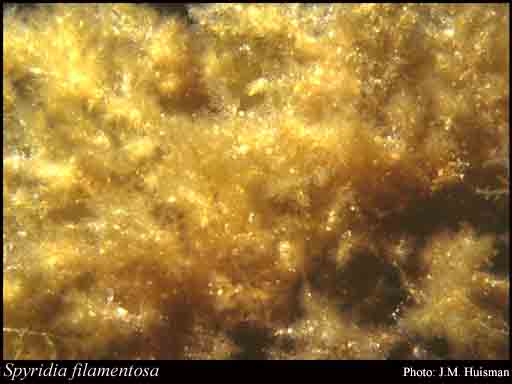- Reference
- Brit.Fl. (Hooker) Edn 4, 2(1):337 (1833)
- Conservation Code
- Not threatened
- Naturalised Status
- Native to Western Australia
- Name Status
- Current

Scientific Description
Habit and structure. Thallus grey to grey-red, sometimes red-brown, 7–18 cm high, lax and soft, irregularly much branched on all sides with longer and shorter branches intermixed, with one to several axes. Holdfast originally discoid, soon becoming fibrous or stoloniferous and entangled; epilithic or epiphytic on various larger algae and seagrasses. Structure. Axes and larger branches corticated, terete; axes 0.5–1(–1.3) mm in diameter, tapering to lesser branches 100–300 µm in diameter; laterals arising from periaxial cells or adventitiously from cortical cells. Segments usually clearly defined on branches, variable in length and proportions but usually L/D (0.2–)0.5–1, with bands of shorter nodal cells and longer internodal cells alternating; nodes with 11–14 periaxial cells, each corresponding to two internodal cells except for the (usually) larger periaxial cell bearing the ramellus. Cortication usually commencing a few mm from the apices but very variable, consisting of rhizoidal cells lying between the internodal cells and gradually forming a continuous cortex 1(–2) cells thick. Ramelli single per segment, irregularly spirally arranged, 0.5–1.5 mm and 12–20(– 27) cells long, cylindrical or gently tapering apart from the terminal 2–3 very short cells which taper abruptly to a mucronate cell, (35–)40–55(–65) µm thick with cells L/D (1.2–)1.5–2.5(–3); mucronate end cell often lost from older ramelli, ramelli with about 9 nodal cells, each usually cutting off 1(–2) cells anteriorly, giving a nodal band 2–3 cells broad. Cells uninucleate; rhodoplasts discoid to elongate, becoming ribbon like.
Reproduction. Gametophytes dioecious. Carposporophytes short-stalked, usually bilobed, lobes globular, 300–700 µm across. Spermatangia covering the lower (except basal) several segments of ramelli, forming male organs 75–120 µm in diameter. Tetrasporangia sessile, 1–3 per cell on lower cells of ramelli, mostly on the upper (adaxial) side, subspherical, 50–75 µm in diameter, tetrahedrally divided.
Distribution. Widely distributed in most temperate and tropical seas. Australia-wide.
Habitat. Generally in conditions of moderate to slight water movement.
[After Womersley, Mar. Benthic Fl. Southern Australia IIIC: 372–374 (1998)]
Distribution
- IBRA Regions
- Carnarvon, Dampierland, Esperance Plains, Northern Kimberley, Pilbara, Swan Coastal Plain, Warren, Yalgoo.
- IBRA Subregions
- Cape Range, Edel, Mitchell, Perth, Pindanland, Recherche, Roebourne, Warren.
- IMCRA Regions
- Central West Coast, Kimberley, Leeuwin-Naturaliste, Ningaloo, Pilbara (nearshore), Pilbara (offshore), Shark Bay, WA South Coast.
- Local Government Areas (LGAs)
- Ashburton, Augusta Margaret River, Broome, Carnarvon, Cockburn, Coorow, Cottesloe, Dandaragan, Denmark, Derby-West Kimberley, East Fremantle, Esperance, Exmouth, Irwin, Karratha, Manjimup, Rockingham, Shark Bay, Wyndham-East Kimberley.